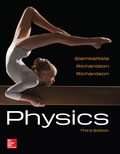
(a)
Find the initial energy stored in the capacitor.
(a)
Answer to Problem 92P
The initial energy stored in the capacitor is
Explanation of Solution
Write the equation for energy.
Here,
Conclusion:
Substitute
Therefore, the initial energy stored in the capacitor is
(b)
Find the initial current through the patient.
(b)
Answer to Problem 92P
The initial current through the patient is
Explanation of Solution
Write the equation for current,
Here,
Conclusion:
Substitute
Therefore, the initial current through the patient is
(c)
Find the energy dissipated in the patient during
(c)
Answer to Problem 92P
The energy dissipated in the patient during
Explanation of Solution
Write the equation for voltage with respect to time,
Here,
Write the equation for energy.
Here,
Then, the energy dissipated in the patient is,
Substitute equation III in IV and then in the above equation.
Conclusion:
Substitute
Therefore, the energy dissipated in the patient during
(d)
Compare the average power supplied by the power source with the power delivered by the patient.
(d)
Answer to Problem 92P
The average power supplied by power source is
Explanation of Solution
Write the average power by source and patient the divide them.
Conclusion:
Substitute
Therefore, the average power supplied by power source is
(e)
Why the capacitors are used in the defibrillator.
(e)
Answer to Problem 92P
The capacitors can produce much higher burst of current to the patient than the power source.
Explanation of Solution
The capacitor used in the defibrillator can produces much higher burst of current to the patient when compared to the burst produces by the power source.
Conclusion:
Therefore, the capacitors are used to produce burst in current to the patients.
Want to see more full solutions like this?
Chapter 18 Solutions
Physics
- A capacitor with a capacitance of C = 5.95×10−5 F is charged by connecting it to a 12.5 −V battery. The capacitor is then disconnected from the battery and connected across an inductor with an inductance of L = 1.55 H . At the time 2.35×10−2 s after the connection to the inductor is made, what is the current in the inductor? At that time, how much electrical energy is stored in the inductor?arrow_forwardCan someone help me with this question. Thanks.arrow_forwardCan someone help me with this question. Thanks.arrow_forward
 College PhysicsPhysicsISBN:9781305952300Author:Raymond A. Serway, Chris VuillePublisher:Cengage Learning
College PhysicsPhysicsISBN:9781305952300Author:Raymond A. Serway, Chris VuillePublisher:Cengage Learning University Physics (14th Edition)PhysicsISBN:9780133969290Author:Hugh D. Young, Roger A. FreedmanPublisher:PEARSON
University Physics (14th Edition)PhysicsISBN:9780133969290Author:Hugh D. Young, Roger A. FreedmanPublisher:PEARSON Introduction To Quantum MechanicsPhysicsISBN:9781107189638Author:Griffiths, David J., Schroeter, Darrell F.Publisher:Cambridge University Press
Introduction To Quantum MechanicsPhysicsISBN:9781107189638Author:Griffiths, David J., Schroeter, Darrell F.Publisher:Cambridge University Press Physics for Scientists and EngineersPhysicsISBN:9781337553278Author:Raymond A. Serway, John W. JewettPublisher:Cengage Learning
Physics for Scientists and EngineersPhysicsISBN:9781337553278Author:Raymond A. Serway, John W. JewettPublisher:Cengage Learning Lecture- Tutorials for Introductory AstronomyPhysicsISBN:9780321820464Author:Edward E. Prather, Tim P. Slater, Jeff P. Adams, Gina BrissendenPublisher:Addison-Wesley
Lecture- Tutorials for Introductory AstronomyPhysicsISBN:9780321820464Author:Edward E. Prather, Tim P. Slater, Jeff P. Adams, Gina BrissendenPublisher:Addison-Wesley College Physics: A Strategic Approach (4th Editio...PhysicsISBN:9780134609034Author:Randall D. Knight (Professor Emeritus), Brian Jones, Stuart FieldPublisher:PEARSON
College Physics: A Strategic Approach (4th Editio...PhysicsISBN:9780134609034Author:Randall D. Knight (Professor Emeritus), Brian Jones, Stuart FieldPublisher:PEARSON





